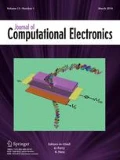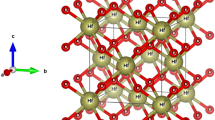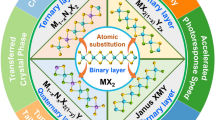Abstract
Electronic and optical properties of monolayer tungsten selenide \((\text {WSe}_2)\) and cadmium zinc telluride \((\text {Cd}_{0.9}\text {Zn}_{0.1}\text {Te})\) heterostructure with VdW, i.e., Van der Waals attractions between two layers, are explored using first-principles calculations. From the results, it is discovered that the proposed heterostructure of \(\text {WSe}_2/\text {Cd}_{0.9}\text {Zn}_{0.1}\text {Te}\) results into nearly direct band gap semiconducting material and has staggered (Type-II) band gap alignment which is required for opto electronic applications. Moreover, the results suggest that for monolayer \(\text {WSe}_2\) and \(\text {Cd}_{0.9}\text {Zn}_{0.1}\text {Te}\), optical absorption is significant in a limited range of visible spectrum (\(\approx\) 420–470 nm) and (\(\approx\) 390–430 nm), respectively, but more absorption takes place in the infrared (IR) region for individual layers. However, the absorption in the \(\text {WSe}_2/\text {Cd}_{0.9}\text {Zn}_{0.1}\text {Te}\) heterostructure results in the red shift phenomenon and high absorption is achieved in the entire visible spectrum (\(\approx\) 410–710 nm). Along with the absorption spectrum, dielectric function, refractive index and optical conductivity of the heterostructure are also calculated agreeing with the trends of each other. Desirable band alignment and high absorption coefficient in the visible spectrum can find applications in photovoltaic cells and other opto electronic devices.








Similar content being viewed by others
References
Choi, W.C., Han, N., Park, G., Akinwande, J., Lee, D., Young, A.: Recent development of two-dimensional transition metal dichalcogenides and their applications. Mater. Today (2017). https://doi.org/10.1016/j.mattod.2016.10.002
Duan, X., Wang, C., Pan, A., Yu, R., Duan, X.: Two-dimensional transition metal dichalcogenides as atomically thin semiconductors: opportunities and challenge. Chem. Soc. Rev. 44, 8859–8876 (2015)
Vogt, P., et al.: Silicine: compelling experimental evidence for graphene like two-dimensional silicon. Phys. Rev. Lett. 108, Art. no. 155501 (2012)
Jeon, J.J., Jeon, S.K., Yoo, S., Park, G., Lee, J.-H., Sungjoo, T.: Controlling grain size and continuous layer growth in two-dimensional MoS2 films for nanoelectronic device application. IEEE Trans. Nanotechnol. 14, 238–242 (2015). https://doi.org/10.1109/TNANO.2014.2381667
Eftekhari, A.: Tungsten dichalcogenides (WS2, WSe2, and WTe2): materials chemistry and applications. J. Mater. Chem. A 5(35), 18299–18325 (2017)
Wurstbauer, U., Miller, B., Parzinger, E., Holleitner, A.W.: “Light” matter interaction in transition metal dichalcogenides and their heterostructures. J. Phys. D Appl. Phys. 50(17), Art. no. 173001 (2017)
Chhowalla, M., Shin, H.S., Eda, G., Li, L., Loh, K.P., Zhang, H.: The chemistry of twodimensional layered transition metal dichalcogenide nanosheets. Nat. Chem. 5(4), 263–275 (2013)
Shi, H., et al.: Exciton dynamics in suspended monolayer and few-layer MoS2 2D crystals. ACS Nano 7(2), 1072–1080 (2013)
Chang, Y.M., Kim, H., Lee, J.H., Song, Y.W.: Multilayered graphene efficiently formed by mechanical exfoliation for nonlinear saturable absorbers in fiber mode-locked lasers. Appl. Phys. Lett. 97(21), Art. no. 211102 (2010)
Eftekhari, A.: Tungsten dichalcogenides (\((WS_2), (WSe_2)\), and \((WTe_2)\)). J. Mater. Chem. A. 5, 55 (2017). https://doi.org/10.1039/C7TA04268J
Kumar, S., Schwingenschlögl, U.: Thermoelectric response of bulk and monolayer \((MoSe_2)\) and \((WSe_2)\). Chem. Mater. 27, 150205124741008 (2015). https://doi.org/10.1021/cm504244b
Cheiwchanchamnangij, T., Lambrecht, W.R.: Quasiparticle band structure calculation of monolayer, bilayer, and bulk MoS2. Phys. Rev. B 85(20), Art. no. 205302 (2012)
Radisavljevic, B., Radenovic, A., Brivio, J., Giacometti, V., Kis, A.: Single-layer MoS2 transistors. Nat. Nanotechnol. 6(3), 147–150 (2011)
Tsai, M.-L., et al.: Monolayer MoS2 heterojunction solar cells. ACS Nano 8(8), 8317–8322 (2014)
James, R.B., Schlesinger, T.E., Lund, J., Schieber, M.: \(\text{Cd}_{1-x}\text{ Zn}_x\text{ Te }\) spectrometers for gamma and X-ray applications. In: Schlesinger, T.E., James, R.B. (Eds.) Vol. 43, pp .335–381. Academic Press, San Diego (1995)
Sordo, S., Abbene, L., Caroli, E., Mancini, A.M., Zappettini, A., Ubertini, P.: Progress in the development of CdTe and CdZnTe semiconductor radiation detectors for astrophysical and medical applications sensors. Appl. Sens 9, 3491–526 (2018). https://doi.org/10.3390/s90503491
Cheng, J., Wang, C., Zou, X., Liao, L.: Adv. Opt. Mater. 2019(7), 1800441 (2009). https://doi.org/10.1002/adom.201800441
Syllaios, A.L., Dean, P.-K., Brian., T.: Optical absorption coefficient of CdZnTe. Proc. SPIE Int. Soc. Opt. Eng. (1994). https://doi.org/10.1117/12.189248
Zakharov, O., Rubio, A., Blase, X., Cohen, M.L., Louie, S.G.: Quasiparticle band structures of six II–VI compounds: ZnS, ZnSe, ZnTe, CdS, CdSe, and CdTe. Phys. Rev. B Condens. Matter 50(15), 10780–10787 (1994)
Shkir, M., Khan, M.T., Ashraf, I.M., et al.: High-performance visible light photodetectors based on inorganic CZT and InCZT single crystals. Sci. Rep. 9, 12436 (2019). https://doi.org/10.1038/s41598-019-48621-3
Novoselov, K.S., Mishchenko, A., Carvalho, A., Neto, A.C.: 2D materials and van der Waals heterostructures. Science 353(6298), Art. no. aac9439 (2016)
Wu, K.M., Gao, H., Yunzhi, H., Yang, A., Wei, J.: Highly-efficient heterojunction solar cells based on two-dimensional tellurene and transition metal dichalcogenides. J. Mater. Chem. A 7, 55–8 (2019). https://doi.org/10.1039/C9TA00280D
Wang, M., Chamberland, N., Breau, L., et al.: An organic redox electrolyte to rival triiodide/iodide in dye-sensitized solar cells. Nat. Chem. 2, 385–389 (2010)
Lin, Y., Ren, P., Weic, C.: Fabrication of \((\text{ MoS}_2)/(\text{ TiO}_2)\) heterostructures with enhanced photocatalytic activity. CrystEngComm. 22, 3377–3526 (2019)
Kresse, G., Furthmüller, J.: Efficient iterative schemes for ab initio total-energy calculations using a plane-wave basis set. Phys. Rev. B 54, Art. no. 11169 (1996)
Perdew, J.P., Burke, K., Ernzerhof, M.: Generalized gradient approximation made simple. Phys. Rev. Lett. 77, 3865–3868 (1996)
Monkhorst, H.J., Pack, J.D.: Special points for brillouin-zone integrations, Phys. Rev. B 13, Art. no. 5188 (1976)
Kochar, R., Choudhary, S.: \((\text{ MoS}_2)\)/phosphorene heterostructure for optical absorption in visible region. IEEE J. Quantum Electron. 54(4), Art no. 7000306 (2018)
Grimme, S.: Semiempirical GGA-type density functional constructed with a long-range dispersion correction. J. Comput. Chem. 27, 1787–99 (2006)
Tran, F., Blaha, B.: Accurate band gaps of semiconductors and insulators with a semilocal exchange-correlation potential. Phys. Rev. Lett. 102, Art. no. 226401 (2009)
Martin, R.M.: Electronic Structure: Basic Theory and Practical Methods. Cambridge University Press, New York (2014). https://doi.org/10.1017/CBO9780511805769
Griffithis, D.J.: Introduction to Electrodynamics. Prentice Hall, Emglewood Cliffs (1999)
Kang, J., Tongay, S., Zhou, J., Li, J.: Band offsets and heterostructures of two-dimensional semiconductors. Appl. Phys. Lett. 102, 012111 (2013). https://doi.org/10.1063/1.4774090
Schutte, W.J., De Boer, J.L., Jellinek, F.: Crystal structures of tungsten disulfide and diselenide. J. Solid State Chem. 70(2), 207–209 (1987). https://doi.org/10.1016/0022-4596(87)90057-0
Tao, F., Gangqiang, Z., Jian, Y., Jiong, L., Zheng, J., Xu, L., Tao, W., Jie, W.: XAFS and XRD studies of the Cd1-xZnxTe crystal fine structure. J. Phys. Conf. Ser. 430(2013), 012087 (2013). https://doi.org/10.1088/1742-6596/430/1/012087
Li, M.-Y., Chen, C.-H., Shi, Y., Li, L.-J.: Heterostructures based on two-dimensional layered materials and their potential applications. Mater. Today 19, 322–335 (2015)
Ding, A., Wang, Y., Ni, Y., Shi, J., Shi, L., Siqi, A.: First principles study of structural, vibrational and electronic properties of graphene-like \((MX_2)\) (M=Mo, Nb, W, Ta; X=S, Se, Te) monolayers. Phys. B Condens. Matter 406, 2254–2260 (2011). https://doi.org/10.1016/j.physb.2011.03.044
Zhu, Z., Cheng, Y., Schwingenschlögl, U.: Giant spin–orbit-induced spin splitting in two-dimensional transition-metal dichalcogenide semiconductors. Phys. Rev. B. 84, 153402 (2011). https://doi.org/10.1103/PhysRevB.84.153402
Won, S., Yun, S.W., Han, S., Cheol, H., Kim, I.G., Lee, J.D.: Thickness and strain effects on electronic structures of transition metal dichalcogenides: 2H-\((MX_2)\) semiconductors (M = Mo, W; X = S, Se, Te). Phys. Rev. B 85(3), 033305 (2012). https://doi.org/10.1103/PhysRevB.85.033305
Shi, H.P., Zhang, H., Yakobson, A., Boris, Y.-W.: Quasiparticle band structures and optical properties of strained monolayer \((MoS_2)\) and \((WS_2)\). Phys. Rev. B 87, 66 (2012). https://doi.org/10.1103/PhysRevB.87.155304
Choudhary, S., Garg, A.: Enhanced absorption in \((WSe_2)/Hg_{0.33}Cd_{0.66}Te\) heterostructure for application in solar cell absorbers. IEEE Trans. Nanotechnol. (2019). https://doi.org/10.1109/TNANO.2019.2941989
Swati, J.: Photoluminescence study of cadmium zinc telluride. Graduate Theses, Dissertations, and Problem Reports. 1252. https://researchrepository.wvu.edu/etd/1252 (2001)
Grimme, S.: Semiempirical GGA-type density functional constructed with a long-range dispersion correction. J. Comp. Chem. 27, 1787–99 (2006)
Sheng, X.C.: Spectrum and Optical Property of Semiconductor, 3rd edn., pp. 76–94. Science Press, Beijing (1992)
Kong, L.-J., Liu, G.-H., Zhang, Y.-J.: Tuning the electronic and optical properties of phosphorene by transition-metal and nonmetallic atom co-doping. RSC Adv. 6, 10919–10929 (2016)
Author information
Authors and Affiliations
Corresponding author
Additional information
Publisher's Note
Springer Nature remains neutral with regard to jurisdictional claims in published maps and institutional affiliations.
Rights and permissions
About this article
Cite this article
Chauhan, A., Maahich, A. & Pal, J. First-principles calculations of the electronic and optical properties of \(\text {WSe}_2/\text {Cd}_{0.9}\text {Zn}_{0.1}\text {Te}\) van der Waals heterostructure. J Comput Electron 20, 13–20 (2021). https://doi.org/10.1007/s10825-021-01659-x
Received:
Accepted:
Published:
Issue Date:
DOI: https://doi.org/10.1007/s10825-021-01659-x




